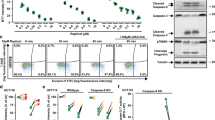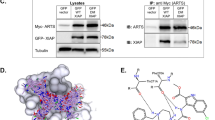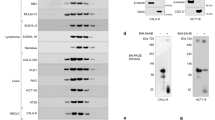Abstract
Bax is a pro-apoptotic member of Bcl-2 family proteins and is central to mitochondria-dependent apoptosis1,2,3. Bax resides in the cytosol as a quiescent protein and translocates into mitochondria after apoptotic stimuli4. Ku70 is a 70K subunit of the Ku complex, which has an important role in DNA double-strand break (DSB) repair in the nucleus5. In another article in this issue, we reported that Ku70 interacts with pro-apoptotic protein Bax in the cytosol and prevents its mitochondrial translocation6, suggesting that Ku70 suppresses Bax-mediated apoptosis. Here, we describe the development of a new membrane-permeable peptide, Bax-inhibiting peptide (BIP) that inhibits Bax-mediated apoptosis, on the basis of the previous finding that showed an interaction between Ku70 and Bax. BIP is comprised of five amino acids designed from the Bax-binding domain of Ku70, and suppresses the mitochondrial translocation of Bax. BIP inhibited Bax-mediated apoptosis induced by staurosporine, UVC irradiation and anti-cancer drugs in several types of cells. BIP may provide valuable information in the development of therapeutics that control apoptosis-related diseases.
This is a preview of subscription content, access via your institution
Access options
Subscribe to this journal
Receive 12 print issues and online access
$209.00 per year
only $17.42 per issue
Buy this article
- Purchase on Springer Link
- Instant access to full article PDF
Prices may be subject to local taxes which are calculated during checkout





Similar content being viewed by others
References
Green, D.R. & Reed, J.C. Mitochondria and apoptosis. Science 281, 1309–1312 (1998).
Gross, A., McDonnell, J.M. & Korsmeyer, S.J. BCL-2 family members and the mitochondria in apoptosis. Genes Dev 13, 1899–1911 (1999).
Wei, M.C. et al. Pro-apoptotic BAX and BAK: a requisite gateway to mitochondrial dysfunction and death. Science 292, 727–730 (2001).
Wolter, K.G. et al. Movement of Bax from the cytosol to mitochondria during apoptosis. J. Cell Biol. 139, 1281–1292 (1997).
Walker, J.R., Corpina, R.A. & Goldberg, J. Structure of the Ku heterodimer bound to DNA and its implications for double-strand break repair. Nature 412, 607–614 (2001).
Sawada, M. et al. Ku70 suppresses the apoptotic translocation of Bax to mitochondria. Nature Cell Biol. 5, 320–329 (2003).
Zhang, Z. et al. The three-dimensional structure of the C-terminal DNA-binding domain of human Ku70. J. Biol. Chem. 276, 38231–38236 (2001).
Ashkenazi, A. & Dixit, V.M. Death receptors: signaling and modulation. Science 281, 1305–1308 (1998).
Matsuyama, S., Llopis, J., Deveraux, Q.L., Tsien, R.Y. & Reed, J.C. Changes in intramitochondrial and cytosolic pH: early events that modulate caspase activation during apoptosis. Nature Cell Biol. 2, 318–325 (2000).
Suzuki, M., Youle, R.J. & Tjandra, N. Structure of Bax: coregulation of dimer formation and intracellular localization. Cell 103, 645–654 (2000).
Hsu, Y.T. & Youle, R.J. Bax in murine thymus is a soluble monomeric protein that displays differential detergent-induced conformations. J. Biol. Chem. 273, 10777–10783 (1998).
Nechushtan, A., Smith, C.L., Hsu, Y.T. & Youle, R.J. Conformation of the Bax C-terminus regulates subcellular location and cell death. EMBO J. 18, 2330–2341 (1999).
Vila, M. et al. Bax ablation prevents dopaminergic neurodegeneration in the 1-methyl- 4- phenyl-1,2,3,6-tetrahydropyridine mouse model of Parkinson's disease. Proc. Natl Acad. Sci. USA 98, 2837–2842 (2001).
Selznick, L.A., Zheng, T.S., Flavell, R.A., Rakic, P. & Roth, K.A. Amyloid β-induced neuronal death is bax-dependent but caspase-independent. J. Neuropathol. Exp. Neurol. 59, 271–279 (2000).
Korsmeyer, S.J. BCL-2 gene family and the regulation of programmed cell death. Cancer Res. 59, 1693s–1700s (1999).
Matsuyama, S., Schendel, S.L., Xie, Z. & Reed, J.C. Cytoprotection by Bcl-2 requires the pore-forming α5 and α6 helices. J. Biol. Chem. 273, 30995–31001 (1998).
Acknowledgements
We thank D.A. Boothman for critical reviewing of the manuscript and encouragement. This work was supported in part by the Blood Center Research Foundation, Northwest Mutual Foundation, American Society of Hematology (Junior Faculty Award) to S.M.
Author information
Authors and Affiliations
Corresponding author
Ethics declarations
Competing interests
The authors declare no competing financial interests.
Supplementary information
Supplementary Figures
Figure S1 Flow cytometric propidium iodide (PI) exclusion analysis. (PPT 402 kb)
Figure S2 Inhibitory effects of BIP against various apoptotic stimuli.
Figure S3 Optimization of Bax-plasmid transfection into Du145 cells.
Rights and permissions
About this article
Cite this article
Sawada, M., Hayes, P. & Matsuyama, S. Cytoprotective membrane-permeable peptides designed from the Bax-binding domain of Ku70. Nat Cell Biol 5, 352–357 (2003). https://doi.org/10.1038/ncb955
Received:
Revised:
Accepted:
Published:
Issue Date:
DOI: https://doi.org/10.1038/ncb955
This article is cited by
-
Variants of the adeno-associated virus serotype 9 with enhanced penetration of the blood–brain barrier in rodents and primates
Nature Biomedical Engineering (2022)
-
In vivo screening reveals interactions between Drosophila Manf and genes involved in the mitochondria and the ubiquinone synthesis pathway
BMC Genetics (2017)
-
Role of two sequence motifs of mesencephalic astrocyte-derived neurotrophic factor in its survival-promoting activity
Cell Death & Disease (2015)
-
Effect of Ku70 expression on radiosensitivity in renal carcinoma 786-O cells
Cancer Cell International (2014)
-
Engineering cells with intracellular agent–loaded microparticles to control cell phenotype
Nature Protocols (2014)



